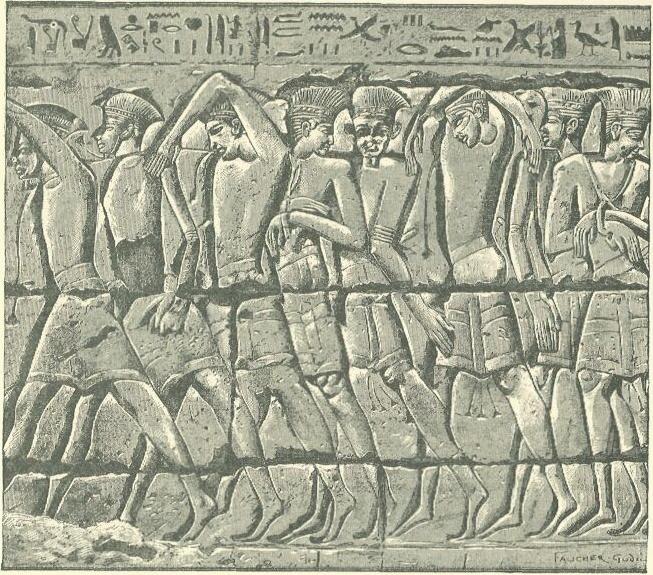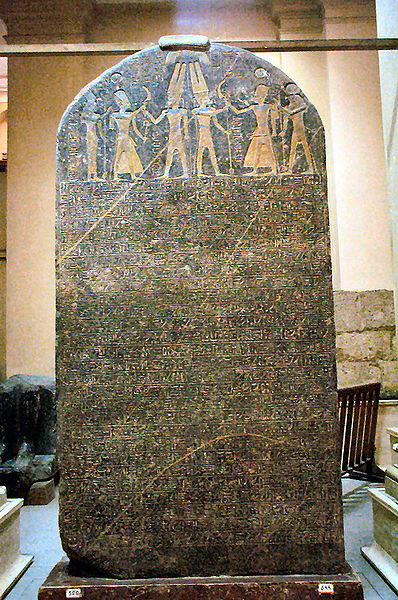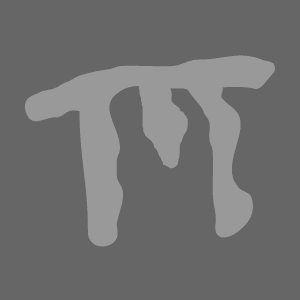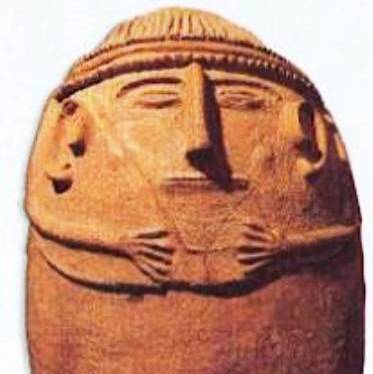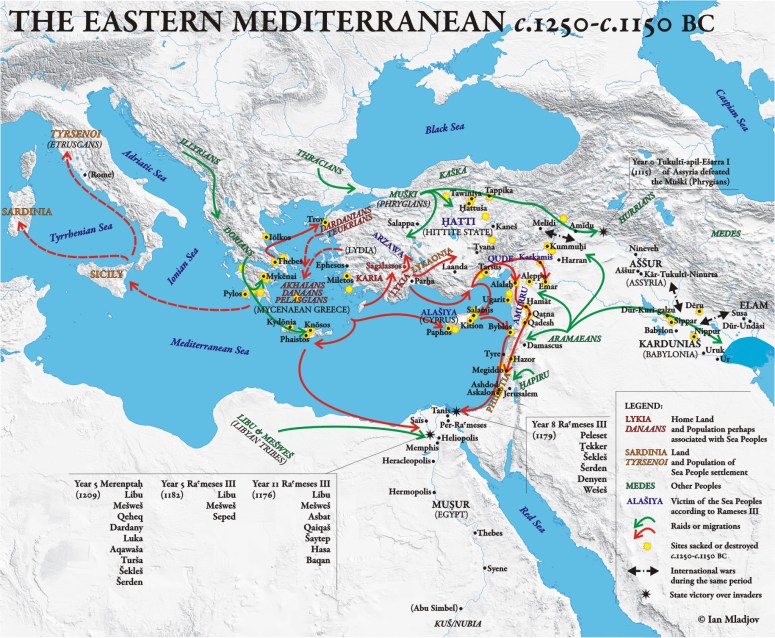|
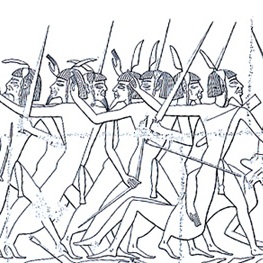
Meshwesh warriors
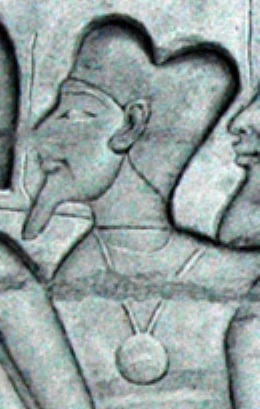
Shekelesh warrior
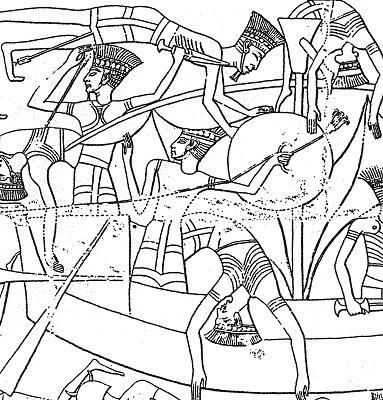
Pelasgian warriors
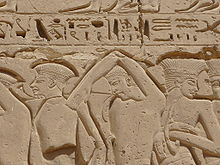
Pelasgian prisoners at M.Habu
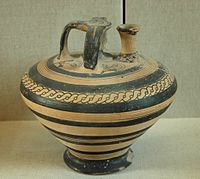
Mycenaean vase founded at Ras-Shamra
|
|
As shown above,
it is possible to identify
four basins of origin of
the Sea Peoples.
There seems to be no doubt that Lubu and
Meshwesh, taking into
account their hairstyle, originated
from Africa; we can
identify the first with
the Libyans
and the latter
with
the populations of the inland oasis, perhaps
Nubians.
The provenance of Lukka,
even described in
some detail in the
Hittite archives, it seems
quite certain ancient
Lycia (Arzawa);
they, however, had access
to the sea, otherwise Hammurapi
III of Ugarit
could not send
them an armed fleet.
Lukka
were, therefore, the
ancestors of Lycians
of the classical world. Also Weshesh
(by: Asya
= Asia Minor)
should be
native
in
southwestern
Asia Minor (Caria?).
More difficulties arise for the identification of other ethnic
groups.
Anatolian
area immediately east of Lycia, also dependent by the Hittite
empire but in contact with the Semitic peoples, should be the
homeland of the circumcised warriors Ekwesh, Shekelesh and
Shardanas.
In the final Bronze Age a place with such requirements can be identified
with Cilicia and the
nearby Pamphylia.
In
the Archaic period, the capital of this region was the city of Sagalassos, that some
studiouses have identified, by assonance, as the
site of origin of Shekelesh.
Teresh
seem to originate from a neighboring area being of thr same cultural extraction of Shekelesh
and wearing in an apparently very similar, although not circumcised.
Many
scholars have pointed out that, in Cilicia, very close to the city
of Adana, where you can locate Denyen, it is situated the city of
Tarsus (Semitic: Tarsish), whose inhabitants may have been Teresh.
Until
the Final Bronze Age, the area was under the control of the Hurites, a population ruled by a dynasty speaking an
Indo-Aryan language, related to the ancient Hindi.
It
is possible that the language of Teresh, Shekelesh and
Shardanas belonged to the Indo-Aryan strain.
We
defer to carry out a thorough investigation on Ekwesh, given the
absence of citations of this people in the reliefs of Medinhet Abu.
Finally,
Pheleset, Tjeker and Denyen, who wear the same feathered headdress, would seem to have come from
an Aegean area, extended to the
south-western Anatolian coast and Cyprus.
The
overall characteristics of the army of the Sea Peoples, in fact,
appear to be conform to the Greek-Mycenaean army as reported
in the Homeric poems: it appears as the expression of
autonomous community-based staff, with its own territory, its complex ethnic structure, its own internal hierarchy.
It
's interesting to note that in the Homeric poems one of the
names by which it is indicated the greek army is Danaans.
It's a minority designation inside the corpus of the occurrences (only 159,
compared with 723 of the Achaeans 227 and of the Argives), but it would seem to indicate an ethnic group in its own right,
the etymology of which fits quite well with that of Denyen of Medinhet
Abu.
It's an ethnos also quite attached to Mycenaean eastern area.
Mycenaean
groups, in fact, began to settle in Anatolia and the Near East as
early as the fifteenth century BC.
In the age of the appearance of the Sea Peoples
at the Egypt's borders,
ceramics type Mycenaean IIIB was spread all over the eastern
Mediterranean.
Just in Cyprus,
in that time, it has concluded also a process of
Mycenaeanisation of the island, that would form a dialect related to
the Arcadian, a script similar to Linear B and the ethnos Da-du-na - as reported
in Assyrian records - whose terminology is adapted to that of the
Homeric Danaans.
As mentioned, the sovereigns of the Danaans , (in the Akkadian form: Da-nu-na) are mentioned in
a letter of Abimilki of Tyre, found in
the archive of Ugarit.
James Mellaart locates their kingdom near Adana (Cilicia,
Turkey), from where the Danaans would sail to regain Cyprus, after
the brief Hittite interlude in 1200 BC.
It
is not excluded that other related to Danaans populations from
Cilicia are settled in Cyprus at the same time.
In the Homeric poems another ethnic group linked to the East
Mycenaean
can be identified among the allies of the
Achaeans: the Teucers.
This name is well suited to Tjekker, which Mellaart proposes to
derive from Pamphylia (south western coast of Turkey) .
The
third people depicted with feathered headdress in Egyptian
inscriptions, the Pheleset , is mirrored in the etymological Aegean.
The Pheleset , in fact, can be identified with the Pelasgians,
a populations living in remote areas of Greece (Arcadia, Thessaly,
part of Crete, some of the Cyclades, not excluding the Aegean coast
of Anatolia),
and in that time, already fully Mycenaean.
Most
scholars believe that the sea people of Pheleset came from the
island of Crete, called Keftiu, by the Egyptians.
This is clear from the identification of Keftiu with the
Biblic name
Caphtor, indicating the originary land of the Philistines, who - as
you will - would not be other than the Pelasgians, settled in
Palestine after the defeat of Djahy .
These
populations, although not all from Greece, were part of the
Greek-Mycenaean Commonwealth, at least to share the same type of
ceramics.
This constitutes a substantial archaeological evidence to identify
the expansion of the Sea Peoples around the Mediterranean costs,
particularly when the findings of Mycenaean III C pottery at neutron analysis,
it reveals not
imported but produced on
site.
While
Teucers and Danaans were definitely speaking a Greek language, it
is still unclear what was the language spoken by the Pelasgians in
the late thirteenth century BC .
|
